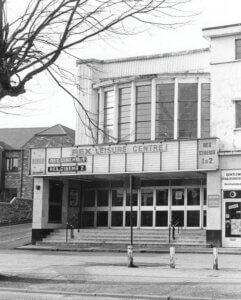Berkhamsted’s Big Screens

As the Rex cinema celebrates its 25th anniversary, we look back over more than 100 years of its predecessors in the town.
Berkhamsted has a long association with the world of the big screen, thanks to the location of the BFI (British Film Institute) National Archive, and with our own Rex cinema celebrating the 25th anniversary of its reincarnation, it seems the perfect time to take a look at the town’s cinematic links.
Before 1911, the townsfolk of Berkhamsted had been treated to the occasional film showing at the Town Hall, or the travelling show that was Taylor’s Royal electric Coliseum de Luxe.
The travelling show had, according to all accounts, been ‘fitted up in the most elaborate style that money and artistry study can produce’.
The town’s first permanent erection designed for showing moving pictures sounds as if it was not quite so grand! The Gem Picture Palace was a corrugated iron hut sitting between the Wesleyan Methodist Church and the Sayers almshouses on Cowper Road. Two houses now occupy the site.
A 10ft screen received images from a single, rather noisy projector to an audience of up to 168 people. Apparently, it was cursed with breakdowns, and the manager was often forced to return the ticket price when the projector jammed. The valiant Kitty Wilkins was the pianist who helped to drown out the sound of the projector.
The Gem did undergo a bit of an upgrade, but thanks to the introduction of the Picture Playhouse its days were numbered. The Picture Playhouse was launched in 1912 in Prince Edward Street in the converted stables at the King’s Arms Hotel – a cinema for 340 people in raked seating, watching a screen measuring 12 by 9ft.

It upgraded the pianist to an additional violinist as well as live acts on occasion, but was a victim of its own success and the Court was subsequently built in 1917, to house a larger audience. The Picture Playhouse eventually had an upgrade of its own as the King’s Hall, until the 1980s. It was later demolished and replaced with the existing Fells House office block.
The Court was built on the site of an old brewery in the High Street on the corner of Water Lane. Named after the Inns of Court Training Corps, which made its home in the town in World War I, this was a far grander affair – with Italian paintings on the walls and seats for an audience of more than 700!

With the aim to entertain soldiers stationed in the town, the regimental band played on opening night and an all-female band was hired to accompany the silent movies. One wonders what the soldiers thought of the film The Growth of Plants, which formed part of the first-night’s programmes!
The Court was extended and transformed once more in 1934, with space for 1,000 filmgoers, and the addition of a Christie organ.

However, the Court too was superceded by the new Rex, and instead became a theatre, hosting performances by the Berkhamsted Amateur Operatic And Dramatic Society (now Berkhamsted Theatre Company), and then the Berkhamsted Repertory Company.
Probably thanks to the war, the Court reverted back to showing films in 1940 – although the Rex continued to show the ‘big’ titles. In 1960 it was sold and converted into a Tesco store. The building was demolished after a fire and the existing Tesco store built.

The Rex, designed in Art Deco style by the architect David E Nye, opened in 1938, with Heidi, starring Shirley Temple as its first screening.
It was an impressive sight, with its double height foyer, art deco pendant chandelier and a round wood and glass ticket booth with chrome trim – quite a step up from that corrugated iron hut 27 years earlier!
It opened on Sundays from 1939 (the Court never opened on Sundays), but by the 1970s it had become too large for purpose, films were shown four days a week (when it was called Studio 1) and from Thursday to Saturday it took on a new persona as a bingo hall.
In 1976 it was renovated at a cost of £90,000, with the stalls handed over for bingo and the circle divided into two screens.
The lease expired in 1988, and the cinema closed with final screenings of The Witches of Eastwick and Teen Wolf Two, but not before the Cinema Theatre Association made efforts to get it listed by English Heritage as a Grade II listed building.
Various attempts to demolish or develop the Rex were made over the years – including one proposal featuring a swimming pool in the auditorium. Eventually, permission was granted for what became the Rex Apartments to be developed, while the foyer was leased to a Fish! restaurant – now it’s The Gatsby.
And in 2002, James Hannaway leased the auditorium, which opened in 2004 following a huge renovation project and has become the successful independent cinema we know today.
Find out what’s showing at www.therexberkhamsted.com.
Images property of Berkhamsted Local History and Museum Society
